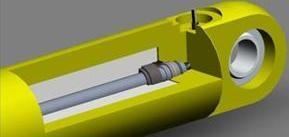 | ||
The position-sensing feature in the position-sensing cylinder provides instantaneous analog or digital electronic position feedback information from the cylinder that indicates the amount of rod extension throughout the range of stroke.
Contents
Internal LDT
In-cylinder linear displacement transducers (LDTs) have been used with limited success in mobile equipment to achieve these goals. A limitation to most in-cylinder LDTs is that the hydraulic cylinder’s piston rod must be bored through its center to accommodate certain elements of the LDT — usually the waveguide tube of a magnetostrictive transducer. The machining and additional production steps associated with “gun drilling” the piston rod add substantial cost to the finished cylinder. And although magnetostrictive LDTs provide extremely high accuracy, this accuracy usually is much greater than is needed for most mobile equipment applications.
Installing linear position sensors into hydraulic cylinders has been a sore subject for cylinder manufacturers for a long time. Extensive fabrication headaches, including gun drilling, the need to stock all different sensor lengths, and handling issues have contributed to industry frustration. CPI has been developing a new generation of sensors which eliminates the need for gun drilling. CPI SL Series Sensors install into standard hydraulic cylinders with minimal modifications and are suitable for field retrofit where rod-type sensors have failed. The cable connector installs into the piston or rod via a 7/16”-20 threaded connector, and the sensor is coupled to the cylinder via a hydraulic hose through a #8 SAE port.
External LDT
External linear displacement transducers (LDTs) eliminate the need for a hollow hydraulic cylinder rod. Instead, an external sensing “bar” utilizing Hall-Effect technology senses the position of the hydraulic cylinder’s piston. This is accomplished by the placement of a permanent magnet within the piston. The magnet propagates a magnetic field through the steel wall of the hydraulic cylinder, providing a locating signal to the sensor. The external LDT has the following advantages over the internal LDT.
Conclusion
In addition, certain sensing technologies exhibit greater long-term reliability than others. Internal sensors represent the most reliable solutions. In addition, external cables or wires may be adversely affected by ice, bush and tree limbs, or any other external obstructions that may be encountered.
